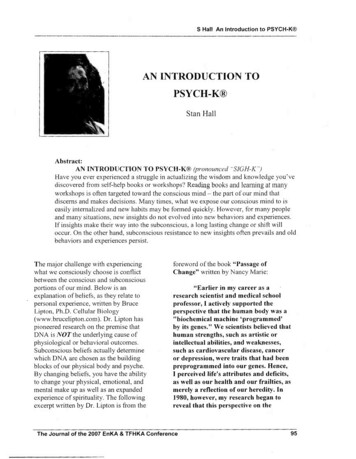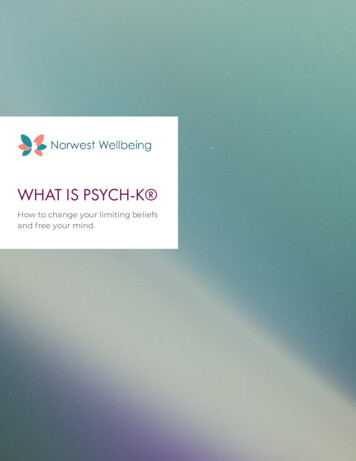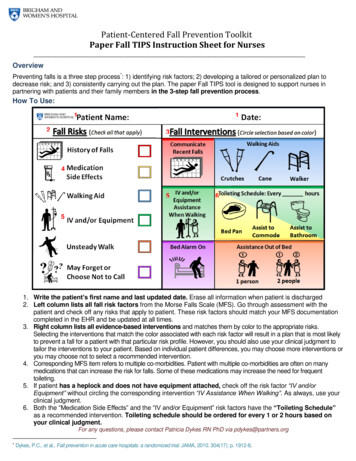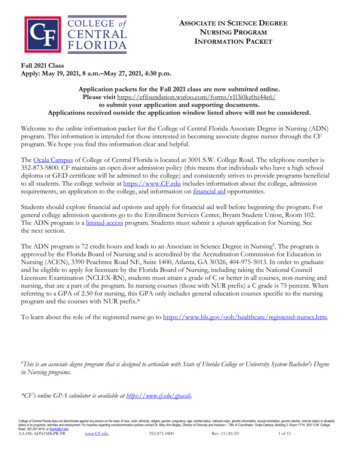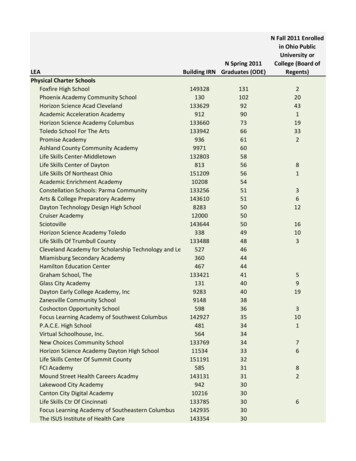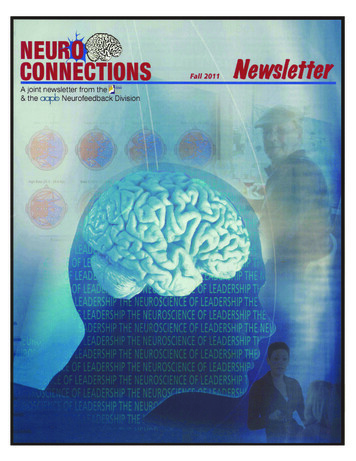
Transcription
NeuroConnectionsFALL 2011qEEG Reveals InteractiveLink Between The PrinciplesOf Business, The Principles ofNature and the s,MAIntroductionAt first glance, neuroscience and business may seeman odd juxtaposition.Our involvement in theinvestigation of these two topics began in 2001.Working for many years with a colleague at ArizonaState University, including the leadership researchdone at the United States Military Academy at WestPoint, the connection between neuroscience andbusiness received worldwide recognition. This workyielded evidence those successful leaders, whethermilitary or civilian, used their brains differently thanless effective leaders, and was featured in aSeptember 20, 2007 article (This Is Your Brain on theJob) that appeared in the Wall Street Journal. Manyother articles followed, appearing in national andinternational publications. We offer new researchand insights, along with an effective appliedleadership process that has been time-tested tocreate sustainable success.Default mode networkIn recent years, a series of papers presentedinsights, derived from qEEG investigations, into theoperation of a more efficient default network ineffective vs. less effective leaders.The understanding and acceptance of theexistence of the brain’s default network has helpedus better understand that there are regions of thebrain characterized by decreased neural activityduring goal-oriented tasks. We have come to knowthe relationship of these regions as a ‘‘default mode’’of brain function. Studies suggested that the brain’sdefault mode supports self-referential mentalactivity. To quote Marcus E. Raichle, whose researchgroup in 2001 first identified the default modenetwork “When healthy people engage in a veryfocused activity, they in a sense, lose themselves. Ifyou really are engaged in something, you kind offorget yourself, and that loss of self corresponds tothe deactivation we observe in brain scans of thedefault networks {Dryden, 2009 1}”.In a follow up fMRI study, Raichle andcolleagues identified a group of individuals whosebrain images indicated that they were unable to"lose themselves" in work, music, exercise or otheractivities that enable most healthy people to get"outside" of themselves, and interestingly, it turnedout that these were highly stressed, depressedindividuals, people whose emotions and thinkingmaladaptively colored their response to theirenvironment, the task at hand, or the people aroundthem {Sheline, 2009 2}. So perhaps Raichle’s resultsgive us a hint regarding the significance of the moreefficient default mode network in the qEEGleadership study: Simply put, the ability to maintaineffective relationships with others, begins with ahealthy relationship with self; begins with a healthyrelationship to thoughts, beliefs and emotions whichsubconsciously influence our own behavior andjudgment (see figure 1).The literature related to the default networkindicates brain activity that offers an awareness mentalizing, and most recently selfprojection. Damien Fair (2008) 3 explains thatR BA10 (4, 54, -8)R Rostral AC (18, 19, 28)Temporal CortexCortexL Lateral Temperal(-44, -15, -5)R Hippocampus(19, -27, -7)L Lateral Temporal Cortex (-55, -2, -21)Lateral Temporal Cortex (-50, 1, -27)L Lateral TemperalTemporal CortexCortex(-43, -16, -5)L Lateral Temporal Cortex (-52, 1, -27)L BAB (-11, 14, 50)L Dorsal AC(-18, 18, 38)R Lateral Parietal Cortex(42, -71, 13)L BA10(-4, 53, -3)L Parahippocampal gyrus(-22, -31, -18)L Amygdala (-22, -6, -13)Figure 1: Default mode network illustrated in blue. Note highdegree of overlap with additional colored regions reflectingmaladaptive sustained activation during task in depressedindividuals. {Sheline, 2009 2} Free via Open Access: OA.Page 1
NeuroConnectionsFALL ted network.Using resting-state functional connectivity MRI(rs-fcMRI) mapping to characterize the developmentof the brain's default network, Fair and hiscolleagues found that the default regions are onlysparsely functionally connected at early school age(7–9 years old); over development, these regionsintegrate into a cohesive, interconnected network.Fair and his group of researchers consider thedefault network as a functionally interconnecteddefault system that is required for internally directedmental activity.They explain that it stands toreason that the default system should demonstratea mature, or near mature, pattern of functionalconnectivity at a time in development wheninternally directed mental activity is demonstrable.We would contend that the research they presentregarding the autobiographical self, stimulusindependent thought, mentalizing, and self-projectionis another way of describing subconscious beliefs,and their potential impact on a leader’s way ofrelating to others 3.Right hemisphere and emotionalengagementPrevious work by the Arizona State Universitygroup also included insights into the crucial rolewhich engagement of right hemisphere empatheticnetworks play in effective leadership. In asubsequent study involving 46 senior leaders, thosewho scored highest for their charismatic, visionaryand socialized communication style demonstratedincreased engagement of right frontal networks,suggesting a capacity to engage empathically inmotivating their workgroup 4.This work helps to understand the internalmechanisms that enable some people to be effectiveleaders and lent further support to the idea thatneuroscience will help us to know how some peoplecan form effective leadership relationships, and whysome people can sustain their effectiveness andothers cannot 5.Goleman, Boyatzis & McKee, (2002) in their bookPrimalLeadershipandResonant Leadership(Boyatzis & McKee, 2005), synthesized theirresearch to help us understand and to support ships with those around them. They also saythat less effective leaders or those that are moreone-sided in their leadership style seem to createdissonant relationships 6.In Boyatzis’ exploratory fMRI study (2011),preliminary observations revealed that nificantly activated 14 regions of interest in theChildrenAdultsmPFC (anterior)mPFC (ventral)sup. frontalinf. temporalparahippocampalpost.cingulatelat. parietalretrosplenialcerebellar tonsilsFigure 2) Default regions are only sparsely connected inchildren aged, 7-9 years old, but become a highly integratednetwork by age 21. Fair et al 2008. Free via Open Access:OAbrain, while dissonant leaders activated 6 anddeactivated 11 regions. These experiences withresonant leaders activated neural systems involvedin arousing attention (i.e., anterior cingulate cortex),the social or default network (i.e. right inferiorfrontal gyrus), mirror system (i.e., the right inferiorparietal lobe), and other regions associated withapproach relationships (i.e., the right putamen andbilateral insula). Meanwhile, dissonant leadersdeactivated systems involved in social or defaultnetworks (i.e., the posterior cingulate cortex), themirror system (i.e., the left inferior frontal gyrus),and activated those regions associated withnarrowing attention (i.e., bilateral anterior cingulatecortex), and those associated with less compassion(i.e., left posterior cingulate cortex), more negativeemotions (i.e., posterior inferior frontal gyrus). Healso points out that we can begin to understand howthey may be affecting our moods and cognitiveopenness. The authors of this article would haveyou understand that from our most recent researchpresented here identified as the whole-brain state (abi-lateral, symmetrical brain wave pattern) allowsaccess to positive mood and cognitive openness 7.Page 2
NeuroConnectionsFALL 2011Boyatzis’ research claims that negative emotions arestronger than positive emotions 8. He says that thecontagion of negative emotion would ignite astronger neural sequence than positive emotions.This may serve evolutionary functions but,paradoxically, it may limit learning. As aconsequence, arousal of strong negative emotionsstimulates the Sympathetic Nervous System (SNS),which inhibits access to existing neural circuits andinvokes cognitive, emotional, and perceptualimpairment 9, 10, 11.The benefits of a leadership style arousingpositive emotions over negative (P/N) ones have beendemonstrated by Fredrickson and Losada andothers {Fredrickson, 2005 12}. They found that apowerful indicator of what is possible for a system isthe positivity/negativity ratio of feedback; that is,how many instances of positive vs. negativefeedback we can observe in a human interactionprocess, such as a team meeting or in a couple'sconversation. P/N is measured by counting theinstances of positive feedback (e.g. "that is a goodidea";) vs. negative feedback (e.g. "this is not what Iexpected; I am disappointed"). Marcial Losada foundthat high performance teams have a P/N ratio of5.6; medium performance teams have a P/N of 1.9and low performance teams have a P/N of 0.36(there is more negativity than positivity). Theseratios determine the level of connectivity that a teamor workgroup can reach {Losada, 2004 13}. Theydeveloped an empirical model demonstrating thatthe ability of a leader to project a positive emotionaltone directly corresponds to the flexibility andcreativity of these teams; medium performanceteams have dynamics that correspond to a transientlimit cycle that eventually settles into a fixed-pointattractor, representing the inability to escapelimiting routines; and low performance teams havedynamics that correspond to a fixed-point attractor,representing even less flexibility, and leading to adead-end situation from which it's very hard toescape.Some researchers are beginning to hypothesizethat this positive or negative impact of leadership styleon workgroup creativity actually has a neural basis.They argue that the sustainability of leadershipeffectiveness is directly a function of a person’sability to adapt and activate neural plasticity. TheSympatheticNervousSystem(SNS)andParasympathetic Nervous System (PNS) are bothneeded for human functioning. They each have animpact on neural plasticity. Arousal affects thegrowth of the size and shape of our brain.Neurogenesis allows the human to build newneurons. The endocrines aroused in the PNS allowthe immune system to function at its best to helppreserve existing tissue 14.Boyatzis explains that a contagion of positiveemotions seems to arouse the PNS, which stimulatesadult neurogenesis (i.e., growth of new neurons), asense of well-being, better immune tual openness 15, 16, 17. By contrast, there aresuggestions in the neuroscience literature thatanxiety-inducing, or negativity based leaders maynot only undermine morale but may actually impedethe workgroup’s capacity for new learning andcreative growth at a neural level. Elizabeth Gould aPrinceton University psychology professor hasdemonstrated, in rats and primates, the detrimentaleffects of chronic stress on “neurogenesis” or thebrain’s capacity to create new neuronal connections18. Ronald Duman (2004) offered similar findings inhuman subjects that suggests that chronic stressdebilitates dendrites and inhibits cell productionwhich causes atrophy of the hippocampus, a part ofthe brain essential for learning and memory andalso implicated in mood disorders, whereas accessto a nurturing adult contributed directly to thedevelopment of healthy brain structure and function19.In Dr. Bruce H. Lipton’s bestseller, The Biology ofBelief, he says, “Our positive and negative beliefs notonly impact our health, but also every aspect of ourlife.” He goes on to say, “Your beliefs act like filterson a camera, changing how you see the world. And,your biology adapts to those beliefs.” 20Obviously, the optimal state of consciousness isto have the qualities and attributes of bothhemispheres operating simultaneously, in order tohave the full response potential of the mind/brainsystem available to us, on an ongoing basis. Thisstate of being can beneficially influence anindividual’s own state of consciousness, andconsequently his or her own performance. Thispositive influence extends to other individuals.A study reported in 1988 in the InternationalJournal of Neuroscience, by researchers at theUniversidad Nacional Autónoma de México, luence nonverbal communication.The study wasdone with thirteen paired subjects. The subjectswere tested in a darkened and soundproof Faradaycage (a lead-lined screened chamber that filters outall outside electromagnetic activity). Each pair ofsubjects was instructed to close their eyes and try to“communicate” by becoming aware of the other’spresence and to signal the experimenter when theyfelt it had occurred. The brainwave states of thesubjects were monitored during this process.Experimenters reported that during the sessions anPage 3
NeuroConnectionsFALL 2011increase in similarity of EEG (brainwave) patternsbetween the pairs of communicators developed.Furthermore, the experimenters noticed, “Thesubject with the highest concordance [hemisphericintegration] was the one who most influenced thesession.” In other words, the EEG patterns of theindividual with less synchrony between the brainhemispheres would come to resemble the EEGpattern of the person whose two sides more closelyresembled each other 21.These conclusions support the proposition thatour thoughts, even nonverbally expressed, caninfluence others. In fact, the more whole-brained webecome, the more we influence others toward thatstate of being as well.Noted physicist David Bohm based his analysisof the nonlocal field on empirical evidence ofquantum theory 22. By 1987, Pribram agreed withBohm’s idea that there is an implicate order to theuniverse that pertains to all matter. As i
NeuroConnections FALL 2011 Boyatzis’ research claims that negative emotions are stronger than positive emotions 8.He says that the contagion of negative emotion would ignite a
